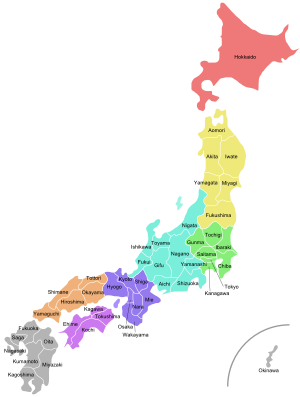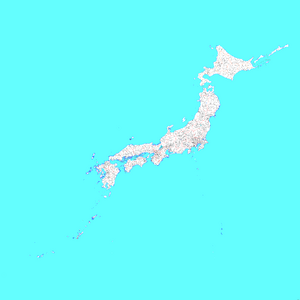التقسيمات الإدارية في اليابان
| التقسيمات الادارية لليابان |
|---|
| المحافظات |
| المحافظات |
| دون المحافظة |
| البلدي |
| دون البلدية |
 |
|---|
|
|
The bureaucratic administration of Japan is divided into three basic levels: national, prefectural, and municipal. They are defined by the Local Autonomy Law of 1947.
Below the national government there are 47 prefectures, six of which are further subdivided into subprefectures to better service large geographical areas or remote islands.
The 1718 municipalities (792 cities, 743 towns, and 183 villages)[1] and 23 special wards of Tokyo are the lowest level of government; the twenty most-populated cities outside Tokyo Metropolis are known as designated cities, and are subdivided into wards.
التقسيم إلى محافظات
The top tier of administrative divisions are the 47 prefectural entities: 43 prefectures (県, ken) proper, two urban prefectures (府, fu, Osaka and Kyōto), one "circuit" (道, dō, Hokkaidō), and one "metropolis" (都, to, Tokyo Metropolis). Although different in name, they are functionally the same.
كن
"Prefecture" (県, ken) are the most common types of prefectural divisions total of 43 ken. The kanji (character) from which this is derived means "county".
تو
Tokyo Metropolis is referred to as a "metropolis" (都, to) after the dissolution of Tokyo City in 1943, Tōkyō-fu (Tokyo Prefecture) was upgraded into Tōkyō-to and the former Tokyo City's wards were upgraded into special wards. The kanji (character) from which this is derived means "capital".
فو
Osaka Prefecture and Kyoto Prefecture are referred to as an "urban prefecture" (府, fu). The Chinese character from which this is derived implies a core urban zone of national importance in middle period of China, or implies a sub division of a province in late period of China.
دو
Hokkaido is referred to as a "circuit" (道, dō), this term was originally used to refer to Japanese regions consisting of several provinces. This was also a historical usage of the character in China meaning circuit.
التقسيمات دون المحافظة
There are only two types of subprefectural divisions: subprefecture and district.
Subprefecture
Subprefectures (支庁, shichō) are a Japanese form of self-government which focuses on local issues below the prefectural level. It acts as part of the greater administration of the state and as part of a self-government system.[2]
المقاطعة
Districts (郡, gun) were administrative units in use between 1878 and 1921 that were roughly equivalent to the counties of China or the United States. In the 1920s, municipal functions were transferred from district offices to the offices of the towns and villages within the district. District names remain in the postal address of towns and villages, and districts are sometimes used as boundaries for electoral districts, but otherwise serve no official function. The Classical Chinese character from which this is derived means commandery.
التقسيمات البلدية
The municipal divisions are divided into three main categories city, town, and village. However the city entities are further categorized. The Special wards of Tokyo are also considered to be municipal divisions.
المدن
Cities in Japan are categorized into four different types, from the highest the designated city, the core city, the special city, and the regular city at the lowest.
مدينة مشهرة
A city designated by government ordinance (政令指定都市, seirei shitei toshi), also known as a designated city (指定都市, shitei toshi) or government ordinance city (政令市, seirei shi), is a Japanese city that has a population greater than 500,000 and has been designated as such by an order of the cabinet of Japan under Article 252, Section 19 of the Local Autonomy Law. Designated cities are also subdivided into wards.
مدينة لب
A core city (中核市, Chūkakushi) is a Japanese city that has a population greater than 300,000 and an area greater than 100 square kilometers, although special exceptions may be made by order of the cabinet for cities with populations under 300,000 but over 200,000.[3] Core city was created by the first clause of Article 252, Section 22 of the Local Autonomy Law of Japan.
مدينة خاصة
A special city (特例市, Tokureishi) of Japan is a city with a population of at least 200,000. This category was established by the Local Autonomy Law, article 252 clause 26.
مدينة
A city (市, shi) is a local administrative unit in Japan with a population of at least 50,000 of which at least 60% of households must be established in a central urban area, and at least 60% of households must be employed in commerce, industry or other urban occupations. Cities are ranked on the same level as towns (町, machi) and villages (村, mura); the only difference is that they are not a component of districts (郡, gun). Like other contemporary administrative units, they are defined by the Local Autonomy Law of 1947.
بلدة
A town (町, chō or machi) is a local administrative unit in Japan. It is a local public body along with prefecture (ken or other equivalents), city (shi), and village (mura). Geographically, a town is contained within a prefecture.
القرية
A village (村, mura, sometimes son) is a local administrative unit in Japan. It is a local public body along with prefecture (県, ken, or other equivalents), city (市, shi), and town (町, chō, sometimes machi). Geographically, a village's extent is contained within a prefecture. It is larger than an actual settlement, being in actuality a subdivision of a rural district (郡, gun), which are subdivided into towns and villages with no overlap and no uncovered area.
Special Ward
The special wards (特別区, tokubetsu-ku) are 23 municipalities that together make up the core and the most populous part of Tokyo Metropolis, Japan. Together, they occupy the land that was originally the Tokyo City before it was abolished in 1943 to become part of the newly created Tokyo Metropolis. The special wards' structure was established under the Japanese Local Autonomy Law and is unique to Tokyo Metropolis.
التقسيمات دون البلدية
Ward
A ward (区, ku) is a subdivision of the cities of Japan that are large enough to have been designated by government ordinance.[4]
التاريخ
Although the details of local administration have changed dramatically over time, the basic outline of the current two-tiered system since the abolition of the han system by the Meiji government in 1871 are similar. Before the abolition of the han system, Japan was divided into provinces (国, kuni) then subdivided into districts (郡, gun) and then villages (里/郷, sato) at the bottom.
التراتب الهيكلي
| للمحافظة | Subprefectural | Municipal | Submunicipal | |
|---|---|---|---|---|
| Prefectures (excluding Tokyo Metropolis) |
Subprefecture | "designated city" | Ward | |
| District | Town Village |
none | ||
| Subprefecture | District | |||
| "core city" "special city" City | ||||
| Metropolis | City Special wards | |||
| District Subprefecture |
Town Village | |||
| Level | Type | Kanji | Romaji | No. | ||
|---|---|---|---|---|---|---|
| Prefectural | Tokyo Metropolis | 都 | to | 1 | Tokyo (東京都 Tōkyō-to) | |
| "circuit" | 道 | dō | 1 | Hokkaido (北海道 Hokkaidō) | ||
| "urban prefecture" | 府 | fu | 2 | Kyoto Prefecture (京都府 Kyōto-fu) and Osaka Prefecture (大阪府 Ōsaka-fu) | ||
| Prefecture | 県 | ken | 43 | Prefectures except Tokyo, Hokkaido, Kyoto Prefecture and Osaka Prefecture | ||
| Subprefectural | Subprefecture | 支庁 | shichō | 158 | ||
| District | 郡 | gun | 374 | |||
| Municipal | "designated city" | 政令指定都市 | seirei shitei toshi | 20 | ||
| "core city" | 中核市 | chūkaku-shi | 42 | |||
| "special city" | 特例市 | tokurei-shi | 40 | |||
| City | 市 | shi | 792 | Including designated, core and special cities. | ||
| Town | 町 | chō or machi | 743 | |||
| Village | 村 | mura or son | 183 | |||
| Special ward | 区 (特別区) | ku (tokubetsu-ku) | 23 | Special wards of Tokyo (東京都区部 Tōkyō-to kubu), 23 wards of Tokyo (東京23区 Tōkyō nijūsan-ku) | ||
| Submunicipal | Ward | 区 (行政区) | ku (gyōsei-ku) | 175 | Only used for designated cities | |
| ISO | Prefecture | Kanji | Region | City [all-types] (Special ward) |
Ward | District | Town | Village |
|---|---|---|---|---|---|---|---|---|
| JP-23 | 愛知県 | Chūbu | 38 | 16 | 7 | 14 | 2 | |
| JP-05 | 秋田県 | Tōhoku | 13 | 6 | 9 | 3 | ||
| JP-02 | 青森県 | Tōhoku | 10 | 8 | 22 | 8 | ||
| JP-12 | 千葉県 | Kantō | 37 | 6 | 6 | 16 | 1 | |
| JP-38 | 愛媛県 | Shikoku | 11 | 7 | 9 | |||
| JP-18 | 福井県 | Chūbu | 9 | 7 | 17 | |||
| JP-40 | 福岡県 | Kyushu | 28 | 14 | 12 | 30 | 2 | |
| JP-07 | 福島県 | Tōhoku | 13 | 13 | 31 | 15 | ||
| JP-21 | 岐阜県 | Chūbu | 21 | 9 | 19 | 2 | ||
| JP-10 | 群馬県 | Kantō | 12 | 7 | 15 | 8 | ||
| JP-34 | 広島県 | Chūgoku | 14 | 8 | 5 | 9 | ||
| JP-01 | 北海道 | Hokkaido | 35 | 10 | 66 | 129 | 15[1] | |
| JP-28 | 兵庫県 | Kansai | 29 | 9 | 8 | 12 | ||
| JP-08 | 茨城県 | Kantō | 32 | 7 | 10 | 2 | ||
| JP-17 | 石川県 | Chūbu | 11 | 5 | 8 | |||
| JP-03 | 岩手県 | Tōhoku | 14 | 10 | 15 | 4 | ||
| JP-37 | 香川県 | Shikoku | 8 | 5 | 9 | |||
| JP-46 | 鹿児島県 | Kyushu | 19 | 8 | 20 | 4 | ||
| JP-14 | 神奈川県 | Kantō | 19 | 28 | 6 | 13 | 1 | |
| JP-39 | 高知県 | Shikoku | 11 | 6 | 17 | 6 | ||
| JP-43 | 熊本県 | Kyushu | 14 | 5 | 9 | 23 | 8 | |
| JP-26 | 京都府 | Kansai | 15 | 11 | 6 | 10 | 1 | |
| JP-24 | 三重県 | Kansai | 14 | 7 | 15 | |||
| JP-04 | 宮城県 | Tōhoku | 13 | 5 | 10 | 21 | 1 | |
| JP-45 | 宮崎県 | Kyushu | 9 | 6 | 14 | 3 | ||
| JP-20 | 長野県 | Chūbu | 19 | 14 | 23 | 35 | ||
| JP-42 | 長崎県 | Kyushu | 13 | 4 | 8 | |||
| JP-29 | 奈良県 | Kansai | 12 | 7 | 15 | 12 | ||
| JP-15 | 新潟県 | Chūbu | 20 | 8 | 9 | 6 | 4 | |
| JP-44 | 大分県 | Kyushu | 14 | 3 | 3 | 1 | ||
| JP-33 | 岡山県 | Chūgoku | 15 | 4 | 10 | 10 | 2 | |
| JP-47 | 沖縄県 | Kyushu | 11 | 5 | 11 | 19 | ||
| JP-27 | 大阪府 | Kansai | 33 | 31 | 5 | 9 | 1 | |
| JP-41 | 佐賀県 | Kyushu | 10 | 6 | 10 | |||
| JP-11 | 埼玉県 | Kantō | 40 | 10 | 8 | 22 | 1 | |
| JP-25 | 滋賀県 | Kansai | 13 | 3 | 6 | |||
| JP-32 | 島根県 | Chūgoku | 8 | 5 | 10 | 1 | ||
| JP-22 | 静岡県 | Chūbu | 23 | 10 | 5 | 12 | ||
| JP-09 | 栃木県 | Kantō | 14 | 5 | 12 | |||
| JP-36 | 徳島県 | Shikoku | 8 | 8 | 15 | 1 | ||
| JP-13 | 東京都 | Kantō | 26 (23) | 1 | 5 | 8 | ||
| JP-31 | 鳥取県 | Chūgoku | 4 | 5 | 14 | 1 | ||
| JP-16 | 富山県 | Chūbu | 10 | 2 | 4 | 1 | ||
| JP-30 | 和歌山県 | Kansai | 9 | 6 | 20 | 1 | ||
| JP-06 | 山形県 | Tōhoku | 13 | 8 | 19 | 3 | ||
| JP-35 | 山口県 | Chūgoku | 13 | 4 | 6 | |||
| JP-19 | 山梨県 | Chūbu | 13 | 5 | 8 | 6 | ||
| الإجمالي | 792 (23) | 175 | 307 | 743 | 183 | |||
انظر أيضاً
المراجع
- ^ أ ب Not inducing the six villages in the Kuril Islands dispute area.
- ^ Imperial Japanese Commission to the Louisiana Purchase Exposition. (1903). Japan in the beginning of the 20th century, p. 80.
- ^ "日本財団図書館(電子図書館)Revised Local Autonomy Law". nippon.zaidan.info.
- ^ "Statistical Handbook of Japan 2008" by Statistics Bureau, Japan Archived 7 فبراير 2013 at the Wayback Machine Chapter 17: Government System (Retrieved on 4 July 2009)

